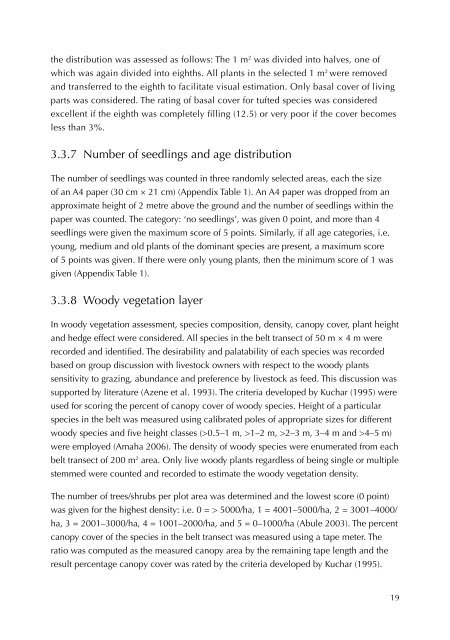Rangeland condition and feed resources in Metema District, North ...
Rangeland condition and feed resources in Metema District, North ...
Rangeland condition and feed resources in Metema District, North ...
Create successful ePaper yourself
Turn your PDF publications into a flip-book with our unique Google optimized e-Paper software.
the distribution was assessed as follows: The 1 m 2 was divided <strong>in</strong>to halves, one of<br />
which was aga<strong>in</strong> divided <strong>in</strong>to eighths. All plants <strong>in</strong> the selected 1 m 2 were removed<br />
<strong>and</strong> transferred to the eighth to facilitate visual estimation. Only basal cover of liv<strong>in</strong>g<br />
parts was considered. The rat<strong>in</strong>g of basal cover for tufted species was considered<br />
excellent if the eighth was completely fill<strong>in</strong>g (12.5) or very poor if the cover becomes<br />
less than 3%.<br />
3.3.7 Number of seedl<strong>in</strong>gs <strong>and</strong> age distribution<br />
The number of seedl<strong>in</strong>gs was counted <strong>in</strong> three r<strong>and</strong>omly selected areas, each the size<br />
of an A4 paper (30 cm × 21 cm) (Appendix Table 1). An A4 paper was dropped from an<br />
approximate height of 2 metre above the ground <strong>and</strong> the number of seedl<strong>in</strong>gs with<strong>in</strong> the<br />
paper was counted. The category: ‘no seedl<strong>in</strong>gs’, was given 0 po<strong>in</strong>t, <strong>and</strong> more than 4<br />
seedl<strong>in</strong>gs were given the maximum score of 5 po<strong>in</strong>ts. Similarly, if all age categories, i.e.<br />
young, medium <strong>and</strong> old plants of the dom<strong>in</strong>ant species are present, a maximum score<br />
of 5 po<strong>in</strong>ts was given. If there were only young plants, then the m<strong>in</strong>imum score of 1 was<br />
given (Appendix Table 1).<br />
3.3.8 Woody vegetation layer<br />
In woody vegetation assessment, species composition, density, canopy cover, plant height<br />
<strong>and</strong> hedge effect were considered. All species <strong>in</strong> the belt transect of 50 m × 4 m were<br />
recorded <strong>and</strong> identified. The desirability <strong>and</strong> palatability of each species was recorded<br />
based on group discussion with livestock owners with respect to the woody plants<br />
sensitivity to graz<strong>in</strong>g, abundance <strong>and</strong> preference by livestock as <strong>feed</strong>. This discussion was<br />
supported by literature (Azene et al. 1993). The criteria developed by Kuchar (1995) were<br />
used for scor<strong>in</strong>g the percent of canopy cover of woody species. Height of a particular<br />
species <strong>in</strong> the belt was measured us<strong>in</strong>g calibrated poles of appropriate sizes for different<br />
woody species <strong>and</strong> five height classes (>0.5–1 m, >1–2 m, >2–3 m, 3–4 m <strong>and</strong> >4–5 m)<br />
were employed (Amaha 2006). The density of woody species were enumerated from each<br />
belt transect of 200 m 2 area. Only live woody plants regardless of be<strong>in</strong>g s<strong>in</strong>gle or multiple<br />
stemmed were counted <strong>and</strong> recorded to estimate the woody vegetation density.<br />
The number of trees/shrubs per plot area was determ<strong>in</strong>ed <strong>and</strong> the lowest score (0 po<strong>in</strong>t)<br />
was given for the highest density: i.e. 0 = > 5000/ha, 1 = 4001–5000/ha, 2 = 3001–4000/<br />
ha, 3 = 2001–3000/ha, 4 = 1001–2000/ha, <strong>and</strong> 5 = 0–1000/ha (Abule 2003). The percent<br />
canopy cover of the species <strong>in</strong> the belt transect was measured us<strong>in</strong>g a tape meter. The<br />
ratio was computed as the measured canopy area by the rema<strong>in</strong><strong>in</strong>g tape length <strong>and</strong> the<br />
result percentage canopy cover was rated by the criteria developed by Kuchar (1995).<br />
19

















